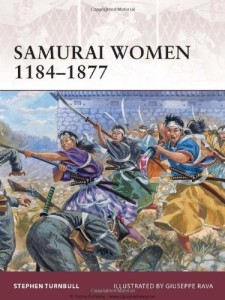Stephen Turnbull
Samurai Women 1184-1877
(Osprey, 2010) 64pp. $18.95
Books in the Osprey Warrior series are primarily made for war-gamers and can vary quite a bit in quality. The difficulties with this slim volume are evident from the beginning. The Introduction makes an enthusiastic, although by now trite, case for the significance of women in Japanese military history. One element in the argument that the women to be discussed “fought bravely and skillfully as authentic female samurai warriors” is a “recent” excavation of three battlefield head mounds that included a surprisingly large number of women. A third of the DNA-tested remains from the battle of Senbon Matsubaru (1580) were women. Two additional excavations “elsewhere” produced “similar results (6).” This raises a good many questions, but those who might want to follow up had better have a working knowledge of the tools of Japanese military history. The battle itself is not mentioned again, but huge numbers of prisoners were executed during Oda Nobunaga’s ten-year struggle (1570-80) against armies fielded by the Ikko-ikki, or self-governing league of the Jodo-Shinshu (True Pure Land sect). The number of executed prisoners, both men and women, is estimated in the tens of thousands (17-18). Were these heads those of executed prisoners who may or may not have been combatants?
Females buried with weapons, armor and wounds have sometimes been described as sacrifices, a technique that avoids dealing with the gender issues presented, but placing large numbers of women in a battle without context or explanation is not an acceptable alternative. The Osprey Warrior series has no footnotes, and the 26-item bibliography of works in English and Japanese is not annotated.
It can be argued truthfully that the series is not aimed at scholars, who should know how to pursue topics of interest, but this volume is also not aimed at those who lack a basic knowledge of Japanese history and military methods – for example, whose head usually winds up in a head mound? A book aimed at beginners should include a few basic information points such as that “Gozen” (as in Tomoe Gozen or Hangaku Gozen) is a title and not a family name. The Introduction includes a 17-item chronology, but there are, unfortunately, no maps in the book, not even battle diagrams.
A book intended for general readers, even a short one, could also include at least some brief discussion of the questions surrounding some of these figures. The most famous of the female warriors, Tomoe Gozen, appears in no sources contemporary with her life, a point surely relevant to any discussion of her career.[1] The question of whether the term “samurai” can be used for women is not addressed.[2] As can be expected, events of more recent times, such as the samurai rebellions of 1868 and 1877 are better documented, but the presentation is still anecdotal. If the lack of discussion reflects a dearth of materials accessible to those who do not read Japanese, that point should be mentioned.
One of the strengths of Osprey publications is visual resources. Photos of period objects are supplemented with illustrations showing them reconstructed and used according to current knowledge. Giuseppe Rava’s illustrations are dynamic and thankfully not prettied-up. Some of the historical illustrations are clearly identified and dated; some are is centuries removed from the events depicted, and in a number of cases it is not made clear just when the illustration of a historic event was made. A number of the illustrations of female warriors also present questions of iconographic gender conventions that are not raised much less answered (17, 21, 52). If, for example, the person shown in the 14th-century Boki-ekotoba with “rouged cheeks and painted eyebrows” is indeed an armed woman, it is eyebrow-raising that everyone else in the picture is apparently totally soused (21). There are very few photographs of artifacts, unusual for this series. One, upper-body armor with a pinched waist, is described as “clearly made to fit the contours of a woman’s body.” It is reminiscent of similar styles in late-medieval or early modern European plate armor. Whether Tsuruhime (1526-44) ever wore this, or it represents someone’s idea of what she should have worn, is another question. There is no discussion of the differences between weapons and armor intended for use by men and those intended for use by women. [3] The photo of the naginata of Matsuhime, daughter-in-law of Oda Nobunaga, seems to show the scabbard rather than the weapon (61).
This short collection of anecdotes with some very interesting illustrations lacks both sufficient guidance for the novice reader – as though no one would start off by reading about women – and sufficient depth for the more knowledgeable reader. It might be useful for a student studying Japanese history who is interested in women and war, but instructors who recommend it should also prepare guidance for further research appropriate to the student’s level because this book does not provide it.
[1] For a discussion of her better documented Nachleben, see Royall Tyler, “Tomoe: The Woman Warrior,” Heroic with Grace: Legendary Women of Japan, ed. Chieko Irie Mulhern (Armonk NY, 1991) pp. 129-61.
[2] For discussion of this point, see http://www.buildingthepride.com/faculty/takeuchi/DrT_Jpn_Culture_files/Nihon_to_files/Female_samurai.htm
[3] Cf. Roald M. Knutsen, Japanese Pole-Arms (London, 1963), plates 9, 10, pp. 122-25.
Valerie Eads
School of Visual Arts

